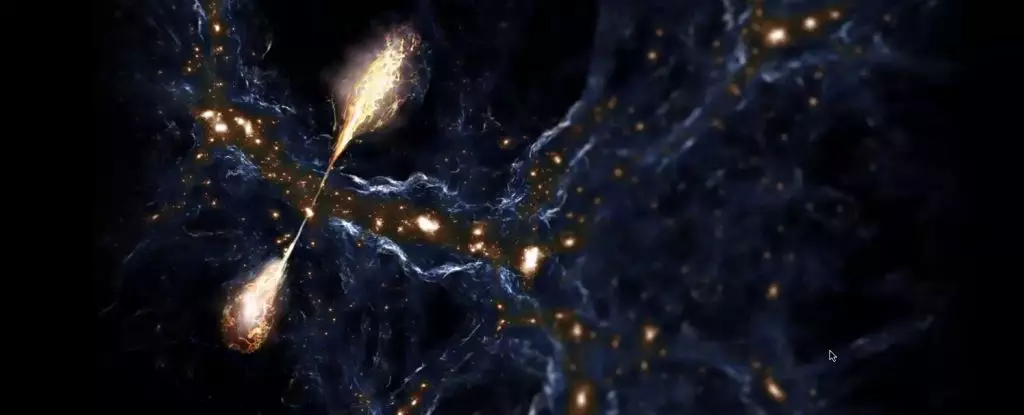Recent astronomical discovery has unveiled a magnificent structure of galactic origin—Porphyrion—a supermassive black hole generating colossal astrophysical jets that stretch across an astounding 7 megaparsecs, equivalent to 23 million light-years. Named after the mythological king of giants in Greek lore, Porphyrion not only showcases the potency of black holes but also serves as a testament to the intricate relationships woven throughout the cosmos. This article seeks to analyze the phenomena behind Porphyrion and the implications it holds for our understanding of the universe.
Astrophysical jets are narrow beams of charged particles accelerated to relativistic speeds by the powerful magnetic fields surrounding black holes. These jets, often released from the poles of a black hole’s accretion disk, consist of plasma and magnetic fields hurtling through space at a significant fraction of light speed. However, the nature of jet formation remains somewhat enigmatic to researchers, making Porphyrion’s discovery a thrilling yet perplexing chapter in astrophysics.
The black hole at the heart of Porphyrion resembles an amoeba scaled to a mere 0.2 millimeters, creating an image of a small organism unleashing streams of energy vast enough to dwarf planetary systems. The enormity and persistence of the jets provide an intriguing challenge to current theories about the physical limits of jet growth. Porphyrion is significant not just for its size but for the scientific questions it raises regarding the mechanisms that promote the stability of such extensive jets.
Comparative Analysis with Alcyoneus
Interestingly, recent findings related to Alcyoneus, another galaxy boasting jets that span an impressive 16 million light-years, suggest that these enormous jets may not be the cosmic anomalies we once believed them to be. Instead, their existence raises the possibility that the conditions required to form such powerful jets are more commonplace than previously thought. Both Alcyoneus and Porphyrion exhibit massive jets that pose serious questions about the rates of black hole feeding and the accompanying reservoirs of matter.
Astrophysical jets are typically tied to a black hole’s feeding cycles, which require amassing immense quantities of matter. The feeding process of these black holes needs continuity over a billion years to sustain the production of such vast structures. Yet, black holes don’t always consistently consume matter on a scale large enough to create jets that extend across such distances.
The Cosmic Puzzle: Stability of Systems
While scientists affirm that these jets can exist, the question arises: How do they maintain stability across such vast stretches of time and space? This question is paramount because theories suggest that jets are inherently unstable structures. Any disturbances, according to research, could lead to their disintegration over time.
However, both Porphyrion and Alcyoneus challenge this assumption, suggesting there might be unidentified factors that contribute to the prolonged stability of jet structures over billions of years. As researchers engage in deeper investigations into the physics of these jets, they may uncover new mechanisms that could explain their resilience.
Integral to understanding the implications of supermassive black holes and their jets is the concept of the cosmic web—a vast infrastructure of dark matter filaments, galaxy clusters, and voids that defines the large-scale structure of the universe. The jets produced by these majestic black holes may play a crucial role in shaping the cosmic web and influencing its characteristics, including temperature anomalies in voids.
The study of Porphyrion’s jets raises potential theories on how they may contribute to unusual thermal conditions in a cosmic void, hinting at their ability to introduce magnetic structures and energy density variations. This interaction reveals the interconnectedness of cosmic elements, demonstrating the profound influence black holes wield over their environments.
Future Discoveries Await
As astrophysical instruments become increasingly advanced, there is a strong expectation that the number of observable galaxies sporting massive jets will soar. Astronomers predict a fertile ground for discovering new galaxies and understanding their role in shaping the universe. Martijn Oei from Leiden University suggests that there are likely many more examples of such galaxies waiting to be uncovered, bringing forth discussions about the fundamental nature of cosmic structures.
The discovery of Porphyrion not only broadens our understanding of supermassive black holes and their jets but also reshapes our conception of cosmic evolution and structure. The questions it raises are as massive as the jets it produces, promising an exciting frontier for future explorations in astrophysics.

